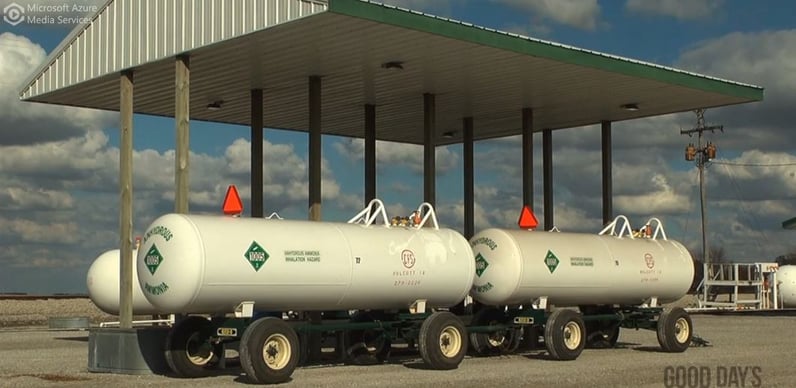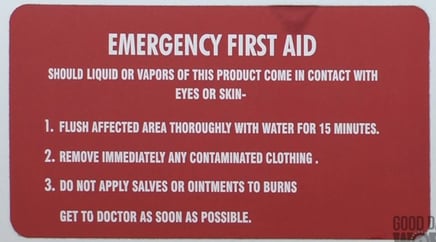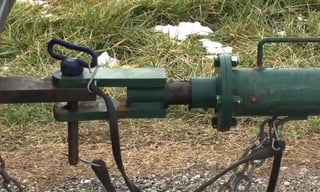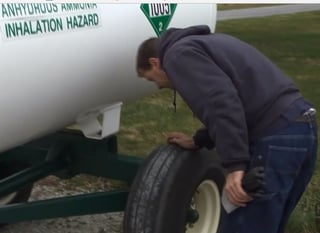Are you and your employees prepared for the fall handling of anhydrous ammonia (NH3)?
Before anyone begins to work around or with anhydrous ammonia it may be best to review your employee roster and see who has been trained and who has not. It is commonly reported that injuries of all types are more prevalent with first year employees. Don’t let new employees slip through the cracks and assume they’ve had adequate training, be absolutely sure. Employees not directly involved with anhydrous should also be trained as they need to know what to do and what not to do should an incident arise. The hazardous nature of working with anhydrous ammonia leaves very little room for error, especially for those who don’t understand the hazards.

Anhydrous ammonia can cause serious injury and even death. Many injuries can be avoided by properly handling the product and respecting it each and every time you work with it and following proper safety procedures. Personal protection is the responsibility of the employer and the employee.
Anhydrous is safe when handled by properly trained and careful individuals. When transported or stored under pressure, anhydrous is a liquid. When released into the atmosphere it rapidly converts to a vapor. At its boiling or vaporizing temperature, NH3 will freeze and dehydrate anything it comes in contact with.
Water, Water, Water
When ammonia is released into the atmosphere it will immediately seek water. In a matter of seconds, it can permanently burn or blind you, it can damage your lungs or completely suffocate you or inflict extreme frostbite. When a person is exposed to ammonia, water is the only first aid that should be used to treat ammonia injuries. That is why water is required at every step where ammonia is handled and readily available in case of an accident. Map out in your mind the route of travel to water in the case of emergency. If your eyes experience a chemical exposure, the burn will force them shut, making it difficult to find the water.  Remember: Water, Water and More Water may mean the difference between a minor or major injury. At the filling site, at least 150 gallons of water in an open top container or a deluge shower must be accessible at all ammonia handling operations. Each nurse tank will be outfitted with 5 gallons of water. It is suggested that 5 gallons of water be stored on the applicator tractor in case the person can’t reach the water on the nurse tank. In addition, it is recommended a person carry a 16 ounce bottle of water on them at all times.
Remember: Water, Water and More Water may mean the difference between a minor or major injury. At the filling site, at least 150 gallons of water in an open top container or a deluge shower must be accessible at all ammonia handling operations. Each nurse tank will be outfitted with 5 gallons of water. It is suggested that 5 gallons of water be stored on the applicator tractor in case the person can’t reach the water on the nurse tank. In addition, it is recommended a person carry a 16 ounce bottle of water on them at all times.

Personal Protective Equipment for NH3
When handling or working around ammonia, it is important to wear tight fitting non-vented chemical splash goggles and loose-fitting gauntlet gloves impervious to ammonia. It is best if gloves have extended cuffs that can be folded back at the elbow to prevent any liquid from running down the glove and onto your clothing. If you wear prescription glasses, find goggles that will fit over them and never wear contact lenses when handling ammonia. It is also recommended to wear a full-face shield to protect your skin. You’ll also need a respirator device rated for protection against fumes of this chemical. In addition, wear a heavy long-sleeved shirt with heavy duty jeans or coveralls. It is also recommended to wear rain gear and rubber boots impervious to ammonia as well. Do not take shortcuts or remove your PPE.
Nurse Tank Safety
 Always use an approved hitch pin with a safety clip when attaching a nurse tank to a towing vehicle. Two safety chains should always be used and correctly crossed under the tongue and attached to a properly rated hitch on the towing vehicle. The chains should be short enough to keep the tongue from touching the ground and strong enough to tow the load. A nurse tank should never leave the bulk plant without the proper equipment: googles and gloves described above, 5-gallon container of fresh water, 16 oz personal eye wash bottle, proper markings, placards and slow-moving vehicle sign. Make yourself aware of the wind direction so that you may always keep yourself upwind of a potential release.
Always use an approved hitch pin with a safety clip when attaching a nurse tank to a towing vehicle. Two safety chains should always be used and correctly crossed under the tongue and attached to a properly rated hitch on the towing vehicle. The chains should be short enough to keep the tongue from touching the ground and strong enough to tow the load. A nurse tank should never leave the bulk plant without the proper equipment: googles and gloves described above, 5-gallon container of fresh water, 16 oz personal eye wash bottle, proper markings, placards and slow-moving vehicle sign. Make yourself aware of the wind direction so that you may always keep yourself upwind of a potential release.
 Before leaving the yard, do a complete inspection of the nurse tank. When transporting the nurse tank be aware of the load you are transporting. Nurse tanks can range up to 12, 000 lbs. and you’ll need plenty of stopping distance to stop larger loads. Nurse tanks should be pulled no faster than 25 mph as this is usually the maximum tire rating. In addition, the tank is also a slow-moving vehicle which can travel no faster than 25 mph. Once the nurse tank is pulled onto public roadways, it falls under the regulatory authority of state and federal DOT laws. You must come to a complete stop prior to crossing all railroad tracks. A maximum of two nurse tanks can be pulled behind any vehicle at one time.
Before leaving the yard, do a complete inspection of the nurse tank. When transporting the nurse tank be aware of the load you are transporting. Nurse tanks can range up to 12, 000 lbs. and you’ll need plenty of stopping distance to stop larger loads. Nurse tanks should be pulled no faster than 25 mph as this is usually the maximum tire rating. In addition, the tank is also a slow-moving vehicle which can travel no faster than 25 mph. Once the nurse tank is pulled onto public roadways, it falls under the regulatory authority of state and federal DOT laws. You must come to a complete stop prior to crossing all railroad tracks. A maximum of two nurse tanks can be pulled behind any vehicle at one time.
Always park the nurse tank on level ground and close enough to the filling station to minimize the stretching or bending of the hose. Chock the wheels and set the parking brake. Tank should never be filled beyond 85% of its water gallon capacity. Never park the nurse tank near a house, building or near livestock.

These are considerations for anhydrous ammonia before the tanks are hooked up to an applicator. There are yet another set of instructions for inspections and safety precautions needed when preparing for field application.
Employees who are potentially exposed to ammonia, either under normal conditions or foreseeable emergencies should be trained . Training must occur at the time of assignment, whenever hazards, conditions, or procedures change and at least annually thereafter.
Safe Handling of Anhydrous Ammonia Blog
Anhydrous Ammonia Standard 1910.111
OSHA FactSheet - Steps to an Effecitve Hazard Communication Program for Employers



